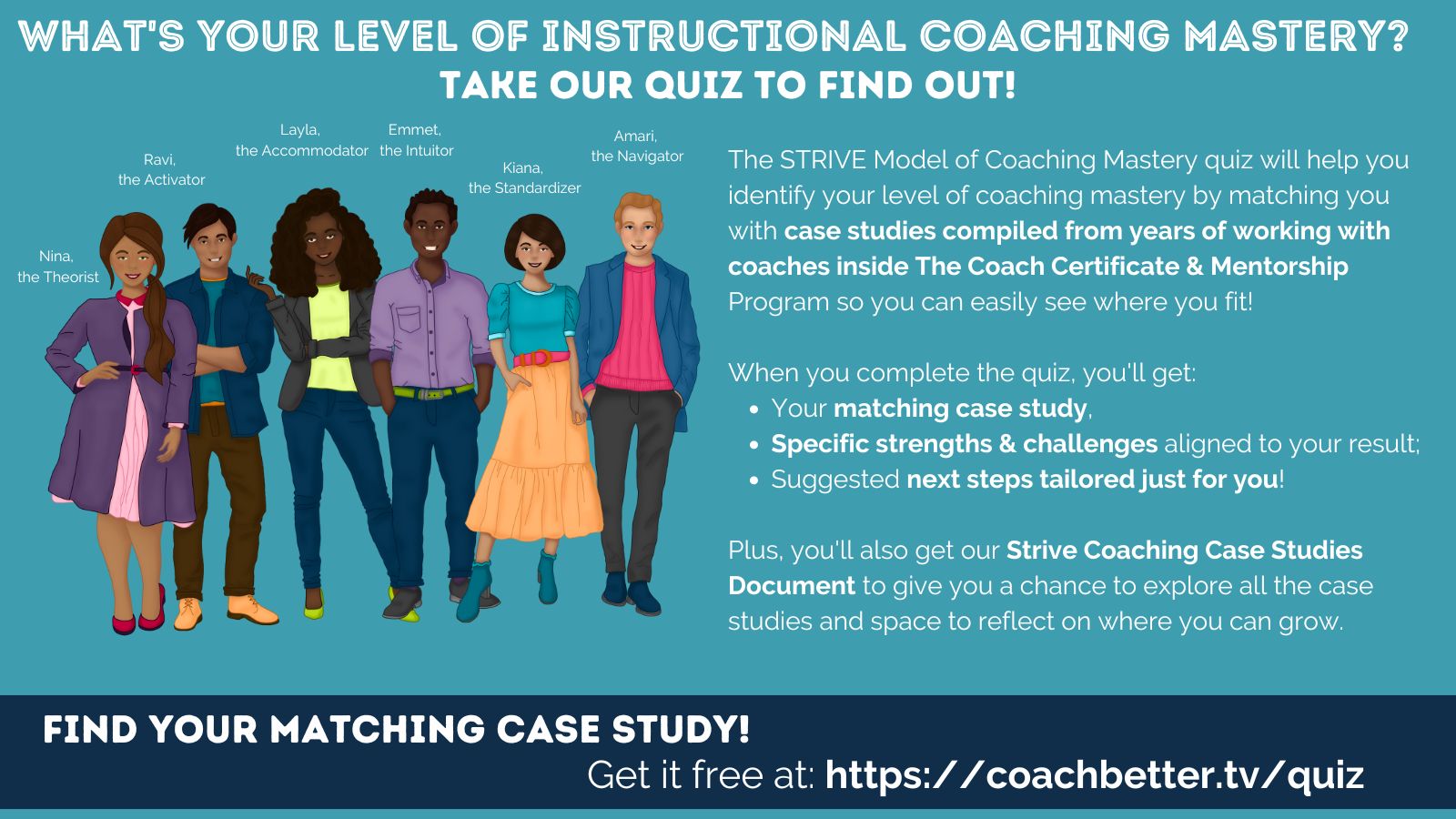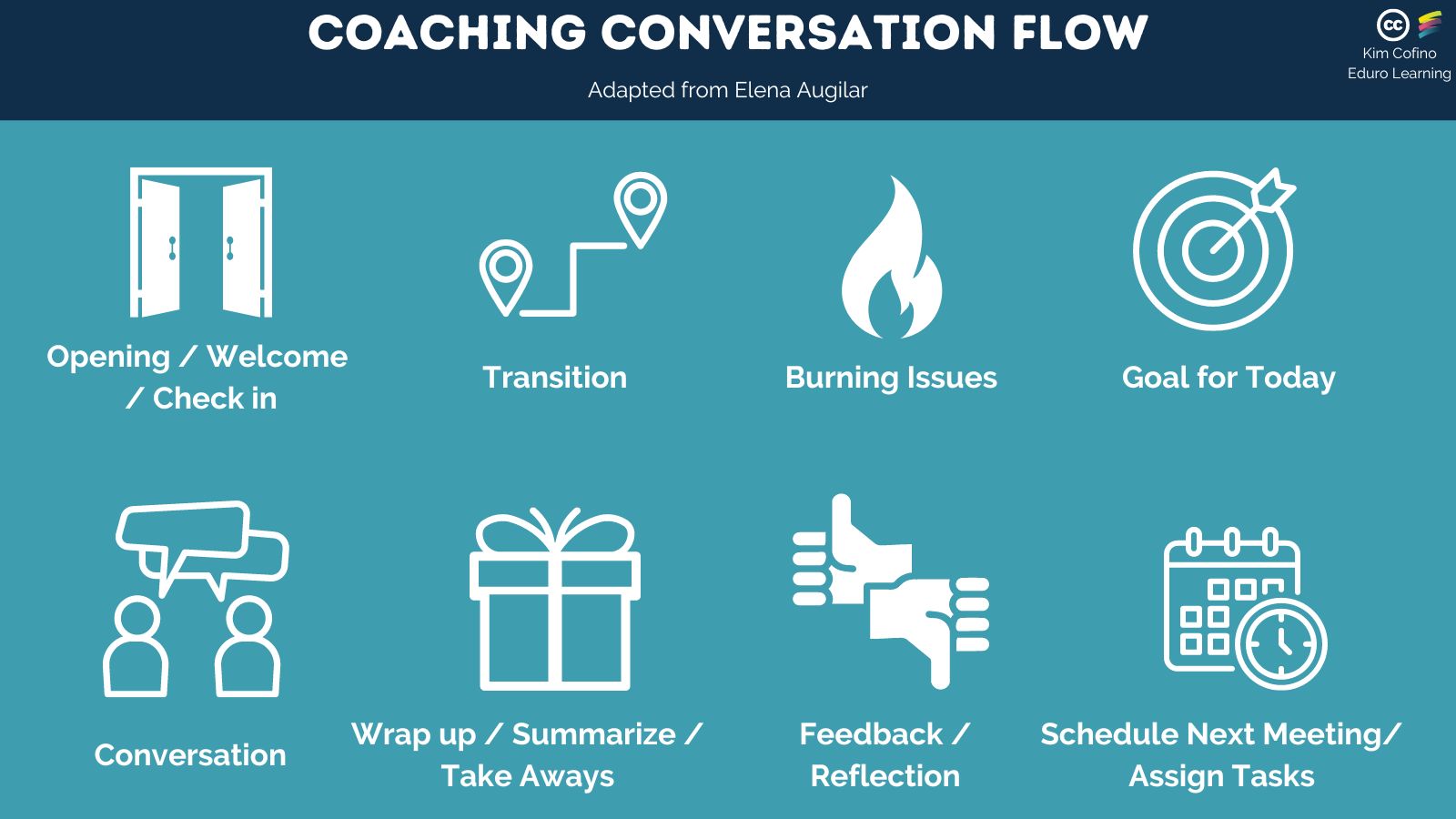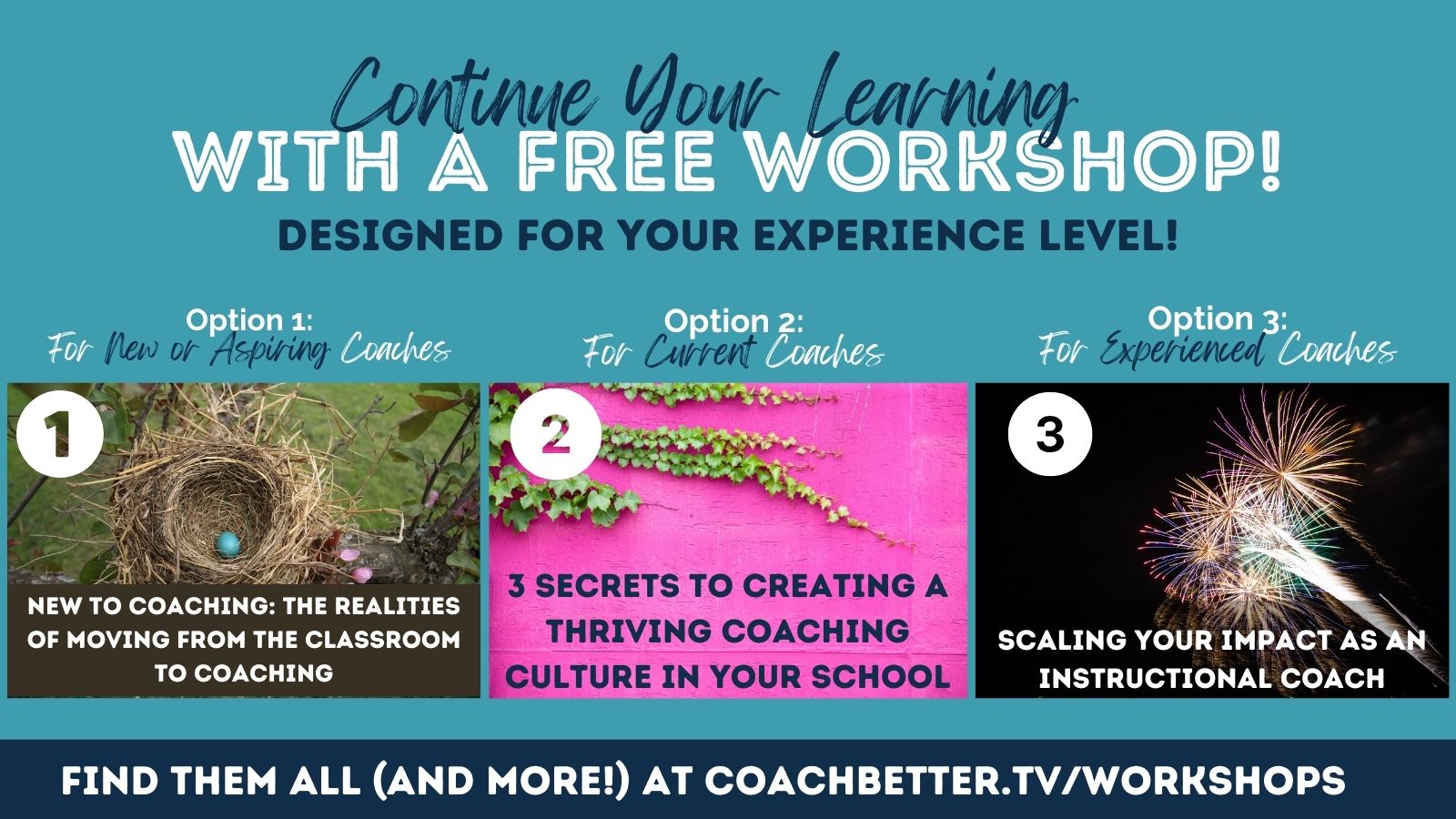It can feel really intimidating to start having coaching conversations because we know we want them to feel purposeful and meaningful, but we also want them to be comfortable enough to feel like a safe space to be vulnerable and take time to process (and not like a formal meeting you might have with a supervisor). So how do you find just the right balance?
In this post, we’re sharing the framework we use in The Coach Certificate and Mentorship Program so you can see the way we structure those conversations. So many of our participants come into the program having seen overly complicated and complex coaching meeting templates and they are so relieved when they find our simple process because it’s easy to implement right away – and adapt as you use it and find your own unique voice as an instructional coach.
Why Follow a Consistent Structure?
One of the special skills of an instructional coach is to be able to facilitate a reflective conversation where your coaching partner feels like they have grown during each conversation they have with you.
Rather than worrying about being a specific content area expert, the skill of planning, facilitating and creating an inclusive conversation experience – for individuals or teams – is a key skill of an instructional coach.
As Diane Sweeney, the author of Student-Centered Coaching, said on #coachbetter episode 144, “Coaching needs to be consistent. Teachers need to know there’s a predictable structure to this work.” Consistency helps coaching partners opt-in and value their time with you.
Having a regular structure for a coaching conversation is bringing Consistency to your coaching practice (the second phase of the Thrive Model and in The Coach Certificate and Mentorship Program). This consistency helps your coaching partner (or partners) choose to opt into a coaching conversation because they know what to expect.
Secondly, when this becomes a routine, it helps your coaching partner know what’s going to happen in the meeting, it feels like following a protocol or a shared structure that provides routine. The structure helps give opportunities for their input as well as to keep things focused.
Finally, this shared process is a third point for you and your coaching partner or partners to collaborate on, so the coaching conversations are engaging and those involved feel a sense of ownership and accountability throughout the process.
What’s YOUR level of coaching mastery?
All coaches go through various stages of coaching mastery. Once you identify where you’re at, you can begin to build the skills needed to move to the next stage.
This quiz is based on real-life case studies compiled from years of working with coaches inside The Coach Certificate & Mentorship Program!
When you receive your results, you’ll also get your matching case study from the STRIVE Case Studies to see where you fit in the stages of coaching mastery.
Ready to tackle your challenges and move on to the next level in YOUR coaching practice?

The STRIVE Model of Coaching Mastery quiz will help you identify your level of coaching mastery by matching you with case studies compiled from years of working with coaches inside The Coach Certificate & Mentorship Program so you can easily see where you fit!
When you complete the quiz, you’ll get:
- Your matching case study,
- Specific strengths & challenges aligned to your result;
- Suggested next steps for each stage;
Plus the Case Study Document includes:
- Case studies leveled by coaching mastery;
- A framework to identify essential stages of professional growth & key areas to focus on in your professional learning;
- Alignment with the THRIVE Model for a Successful Coaching Culture;
- Space for you to reflect & prioritize so you can take action immediately!
You’ll go straight to the Quiz, and get the Case Studies by email
What does a Coaching Conversation Structure Include?
This leads us to utilizing a structure or format to provide this consistency. Kim Cofino developed the “Coaching Conversation Flow”, a format used in The Coach to guide both individual and group coaching and shared as a model for participants to use in their own practice.

The ‘flow’ involves 8 components…
- Check in: this is a chance to welcome your coaching partner to the conversation, catch up on any personal things that have happened, check in on their wellbeing for the day, and get comfortable in this new space for conversation
- the amount of time in this phase should be limited
- Transition: this is time to make a quick connection between whatever was shared in the check in to their burning issues for today
- Burning Issues: what’s on their mind for today – you can reference what you had planned to talk about during your time together, but something else might have come up that might shift the focus
- These first three steps will set the tone for the conversation
- Goals: Clarify what you will focus on today, with a reminder of the goals that you set in this coaching partnership (or at the end of your last meeting)
- Conversation: this is the “meat” of the conversation, when you’re asking just the right questions to help your coaching partner reflect . Consider where you go into the coaching mode with Active Listening, Questioning, pausing, paraphrasing, etc.
- Wrap Up: summarize the conversation – what you accomplished in this conversation, confirm that you both understand the importance of the conversation,, highlighting key outcomes or key actions that need to happen next, acknowledge accomplishments and identify focus for next meeting
- (it’s a check in at the end of the conversation)
- Feedback: this is a chance to debrief with your coaching partner about the process. You can ask what was most helpful for you today? What might you like to do differently next time? Reflection helps us in our own growth as a coach and gives our coaching partner an opportunity to have input on their experience
- Next Meeting & Tasks: As we all get busy with our work, we don’t want to lose the momentum of a productive coaching conversation so we need to identify the who, what, how, and when of next steps.
We’ve looked at the Why and the How of the flow of a coaching conversation but it’s also important to emphasize the power in a simple, shared document to capture the What of you and your coaching partner’s thinking, reflections, ideas, and actions.
Having this in a shared document is extremely valuable because:
- It is available before, during, and after your conversations – a place for planning, sharing, and reference
- It is a collaborative space to interact with your coaching partners in person and asynchronously
- It is a visible demonstration of growth over time
In instructional coaching, there is often a focus on building and utilizing skills like questioning, active listening, and paraphrasing – all important to the success of coaching interactions. However, without structure, the purpose and focus on a coaching conversation may be lost. Whether you use Kim’s Coaching Conversation Flow or Elena Aguilar’s Arc of a Coaching Conversation or another protocol, consider how you’ll provide Consistency in coaching and meetings with individuals and teams so there is a sense of purpose, focus, and confidence in the power and impact of instructional coaching.
Watch the Video
Keep Learning
If you found this post helpful, you’ll also love a few other quick tips from previous seasons:
- The Anatomy of a Great Question: My Favorite Sentence Stems & Coaching Questions
- The 3 Key Roles of an Instructional Coach: Consulting, Collaborating and Coaching
- Knowing How to Switch Stances as an Instructional Coach
- One Question That Will Transform Your Coaching Practice
We also have an awesome free workshop all about developing your coaching conversation skills called Finding Your Voice as an Instructional Coach.
And of course, grab our FREE coaching meeting template today and start using immediately!
All of these resources are great to help you build your toolkit of coaching resources, but the reality is, to have really great coaching conversations you need to learn more than just the structure of a conversation and a list of great questions to ask.
You need to learn how to…
- Deeply listen, and ask the right next question based on what your coaching partner said
- spot the clues and cues to switch stances within a single conversation and over time,
- And most of all, you need to learn how to adapt your coaching practice for each individual coaching partner that you work with.
So, please access those free resources to get started…
And when you’re ready to dig even deeper into developing consistency in your coaching practice, to being more intentional about the way you navigate coaching conversations and coaching cycles with your coaching partners, come join us for our next cohort of The Coach Certificate and Mentorship Program!
Free Workshops for Instructional Coaches
If you’re ready to keep learning, try one of our FREE workshops where you’ll be able to dig deeper into the concepts in this post, and get a peek at all of our courses for coaches.
We have workshops (and courses) to support coaches at every stage of their career: from new and aspiring coaches making the move from classroom to coach; to current coaches ready to be more intentional and strategic in their practice; to established coaches leveraging their coaching experience to lead.

You can them all on our coachbetter website at coachbetter.tv/workshops
If you’re curious right now, you have questions, please reach out. You can leave a comment below, join our #coachbetter Facebook group, or find us on social media at Eduro Learning and send me a DM. I’d love to support you on your coaching journey. See you next time!
Connect with us!
Subscribe to the podcast iTunes |Spotify|Stitcher
Follow us on social media: Instagram |LinkedIn
Join our #coachbetter Facebook group

Recent Comments